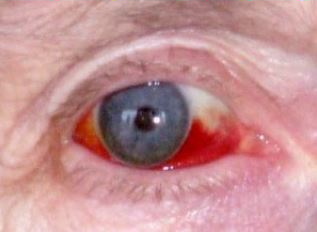A subconjunctival haemorrhage is one cause of a red eye. It is caused by a small bleed behind the conjunctiva. It can look alarming, but it usually causes no symptoms and is usually harmless. The redness usually clears within two weeks.

The conjunctiva is like a thin skin on the front of the eyeball. It covers the white part of the eye (the sclera) but does not cover the central part of the eye (the cornea). In between the conjunctiva and the sclera run tiny blood vessels. If you look closely at the sclera you may just be able to see a few tiny blood vessels. If one of these tiny blood vessels bursts, it bleeds in between the conjunctiva and the sclera. This is called a subconjunctival haemorrhage (bleed).
What causes a subconjunctival haemorrhage?
In the vast majority of cases there is no apparent cause. It just occurs for no apparent reason. Older people tend to have them most. Occasionally, an injury to the eye or a head injury can cause one. Sometimes they occur after a bout of coughing or vomiting. Rarely, they are associated with high blood pressure. If you have a bleeding disorder, you may be more prone to having a subconjunctival haemorrhage (or other bleeding such as nose bleeds or easy bruising). For example, if you have haemophilia or if you take anticoagulant medication (such as warfarin).
What are the symptoms of a subconjunctival haemorrhage?
Usually none. You often do not notice it until someone points it out to you, or you see it in a mirror. It can be alarming, as sometimes a large part of the white of the eye appears red and bloodshot. This is because the tiny haemorrhage spreads between the conjunctiva and the sclera in a thin film. It looks a lot worse than it really is! The central part of the eye, the cornea, is never affected, and so your vision is not affected. It is not uncommon for it to happen again at a later date.
What is the treatment for a subconjunctival haemorrhage?
No treatment is required. They usually fade and disappear within two weeks. (Like any other bruise the red colour will go a yellow/brown colour before it fades away.) Do mention to your doctor if:
- You have not had your blood pressure checked recently.
- You suspect an injury to your eye is the cause. (For example, a small bit of flying metal from a hammer, chisel, etc.)
- You have noticed any other unusual bleeding or bruising of the body for no good reason.

